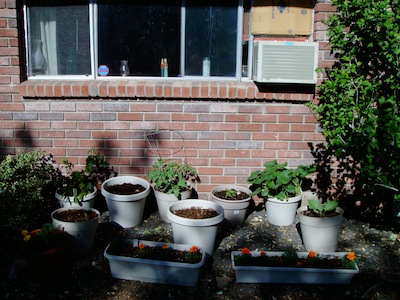It doesn’t take a genius to realize that the cost of food has skyrocketed over the last couple of years. It seems that every time you go into the store that the cost of at least one thing on your list cost a bit more than the time before. So what’s a person to do? Grow some of your own food, that’s what!
Growing your own food isn’t as difficult as you might think, and it doesn’t necessarily take as much space as you might think either. Those images of huge vegetable gardens at grandma’s house are often the norm in rural areas, but growing your own food can be done on a much smaller scale with success and to the extent that it makes a difference in both your nutritional health and your grocery budget.
The first thing you will need to do is decide how extensive you want your garden to be. While your yard (or lack thereof) may help you make this decision, it is important to know that there are ways to enlarge your growing area.
You can…
- Do some container gardening in addition to your garden plot. Container gardening is a great way to grow lettuce, radishes, and even cucumbers and tomatoes (there are varieties developed specifically for container gardening). More specific instructions are available from a number of sources (including the internet, county extension offices, and your local garden center).
- Plant multiple “crops” based upon their growing periods. For instance, peas are an early crop, but once they have been harvested, pull the plants and add in something else. You can sow green beans, or try planting a few more pepper plants that will provide you with peppers well into the fall.
The next thing you need to think about is preparing your site. When deciding on the placement of your garden, make sure it is in a location that gets as much afternoon sun as possible and will be easily reached by a garden hose.
Once all that is done, you are ready to clear your garden spot. To do this, you will remove the sod/grass from the entire planned garden area. After that, you can then either work loamy soil into the ground to promote healthier plants or construct raised beds.
New Manual Reveals Tips and Tricks for Smart Vertical Gardening for Small and Large Spaces
If you are clearing your garden spot, it is important to do a thorough job initially if you want to save yourself a lot of time on your knees pulling weeds later. To clear the sod, you’ll need a sharpshooter shovel (spade) and a wheelbarrow or garden cart. “Cutting” along the perimeter, dig down four to six inches. After you’ve cut the perimeter, cut across in twelve-to-fourteen-inch squares and carefully lift the sod squares out. You can load them into the garden cart and use them in other areas of your yard to fill in bare spots or build up low spots that hold water. To plant the sod squares, press them into the areas you wish to cover and water well. Returning to you garden spot, you’ll need to use a garden shovel and rake to work peat moss and/or loamy garden soil into the existing soil. Loamy soil is soil that contains sand, soil, and decaying organic materials such as dried manure. Once this is done, you’ll be ready to plant.
If you are building raised beds, you will need landscape timbers or stones/blocks, soil, peat moss, a garden shovel, and a rake. Once you’ve decided the size of the perimeter of your garden space, remove the sod using the same method used for ground plots. If you wish, you can put landscape cloth over it as added protection against re-growth.
After you’ve taken care of the grass, you will need to construct a box using the timbers or stones/blocks, making it eighteen-to-twenty-four-inches tall. Fill the box level with a good mixture of garden soil, peat moss, and loamy soil that has a high organic material content. Allow the dirt to settle for two or three days and then add enough to make it level with the top of the box.
Now it’s time to decide what to plant. And if you are like most people, your biggest problem with planting will be choosing what to plant—you’ll want to plant way more than you have room for! But choices have to be made, so here are a few tips to help you decide what to grow in your garden….
- Plant mainly vegetables your family will eat.
- Don’t be afraid to try one or two new vegetables—just plant minimal amounts of them so as not to waste space that is already precious.
- Use trellises for vegetables that vine (such as cucumbers, squash, and miniature pumpkins). This will allow vines to grow up rather than out and taking up space you can use for other vegetables.
- Corn does not do well in small spaces (anything less than fifteen by fifteen feet) or raised beds. For corn to pollinate and grow well, you need to be able to plant several rows (six to eight at a minimum).
- Don’t waste space in your garden growing something that can be grown in a container.
Once you’ve made your choices and all danger of frost is past in your region, it is time to plant your garden. Rows should be spaced twelve to eighteen inches apart for small gardens that will be tended by hand. If you are fortunate to have a larger garden and will be using a tiller to keep your garden weed-free and the soil worked up between the rows, you’ll need to have two to three feet between rows.
So if you are ready… let’s plant!
- Purchase healthy seeds or plants from your local garden center, greenhouse, or nursery. You may need to look online to find a good source of heirloom seeds or plants, as these can be hard to find in some stores. Wherever you get them, make sure you plant only healthy seedlings. A healthy plant is one that is bright green, has four to six sets of leaves, has no blooms on it yet, has a strong, sturdy stem/stalk, and is obviously being watered properly with few (if any) roots growing out of the bottom of the container. NOTE: Onion and potato plants will not have leaves. These are root crops, so they will consist of tiny onions with a thin green top and small potatoes with multiple eyes, respectfully.
- Tomato plants should be planted fairly deep; cover the bottom set of the leaves with soil, setting the plants twelve to eighteen inches apart.
- Pepper plants should be planted in the same fashion as the tomato plants; cover the bottom set of leaves and sett the plants eight to ten inches apart.
- Broccoli and cabbage plants should be planted so that the base of the plant is level to the ground, with the plants ten to twelve inches apart.
- Onions should be planted so that the bulb is three to four inches deep. The tops will not remain upright at first; don’t be distressed if you see your newly planted onions drooping on the ground initially.
- Potatoes should be planted two to four inches deep and spaced six to eight inches apart. It is a good idea to mound a bit of soil up a bit on top of your potatoes.
- Green beans should be a bush variety, not a pole variety. Plant two to three seeds together, one to one-and-a-half inches deep and six to eight inches apart.
- Peas should be planted with three to four peas together; they should be one to two inches deep and four to six inches apart.
- Cucumbers, squash, and zucchini should be planted in hills. To do this, rake mounds of soil approximately two feet in diameter and three feet apart. Firmly press the soil together, making the top fairly flat. Using your thumb, make three indentations that are the depth of your thumb. Drop two or three seeds in each hole and cover with dirt. Place a strong trellis the width of the garden as close as possible to your cucumber and squash hills for the vines to trail up. NOTE: Once the peas are harvested, you can sow miniature pumpkin seeds in their place (trellis included) for fall decorating.
Other vegetables that are fairly easy to grow include eggplant (purchase plants, lettuce, carrots, sweet potatoes, and radishes. Plants that are easy to grow but need more room include watermelon and pumpkins.
Once you’ve planted your garden, you will need to make sure you give it the proper care. This includes regular watering (if rain is in short supply), keeping your garden weed free, keeping the soil worked up to allow for optimal growing conditions, keeping the garden pests out of your garden, and harvesting your vegetables.
Water: Your garden should never have water standing in it, and the soil should always be loose to allow for proper drainage.
Weeds: Checking your garden daily or every other day for weeds and pulling every one you see will keep weeds from getting out of hand.
Pests: Garden pests can be deterred and destroyed by planting marigolds around the perimeter of the garden or by spraying a mixture of water and dish soap on your plants (one teaspoon of soap to one quart of water).
Harvesting is the yummy and easy part. Plants and seed packets will provide you with the necessary information on maturation times for the varieties of plants you select. Enjoy your harvest!
©2013 Off the Grid News
 Off The Grid News Better Ideas For Off The Grid Living
Off The Grid News Better Ideas For Off The Grid Living





